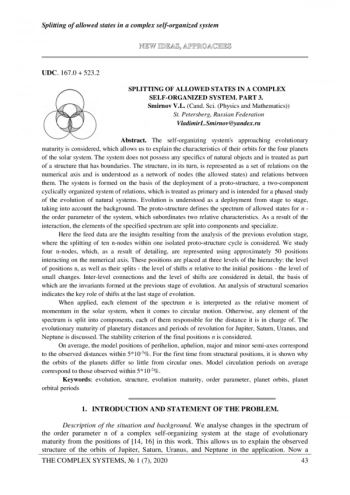The self-organizing system’s approaching evolutionary maturity is considered, which allows us to explain the characteristics of their orbits for the four planets of the solar system. The system does not possess any specifics of natural objects and is treated as part of a structure that has boundaries. The structure, in its turn, is represented as a set of relations on the numerical axis and is understood as a network of nodes (the allowed states) and relations between them. The system is formed on the basis of the deployment of a proto-structure, a two-component cyclically organized system of relations, which is treated as primary and is intended for a phased study of the evolution of natural systems. Evolution is understood as a deployment from stage to stage, taking into account the background. The proto-structure defines the spectrum of allowed states for n - the order parameter of the system, which subordinates two relative characteristics. As a result of the interaction, the elements of the specified spectrum are split into components and specialize. Here the feed data are the insights resulting from the analysis of the previous evolution stage, where the splitting of ten n-nodes within one isolated proto-structure cycle is considered. We study four n-nodes, which, as a result of detailing, are represented using approximately 50 positions interacting on the numerical axis. These positions are placed at three levels of the hierarchy: the level of positions n, as well as their splits - the level of shifts n relative to the initial positions - the level of small changes. Inter-level connections and the level of shifts are considered in detail, the basis of which are the invariants formed at the previous stage of evolution. An analysis of structural scenarios indicates the key role of shifts at the last stage of evolution.
When applied, each element of the spectrum n is interpreted as the relative moment of momentum in the solar system, when it comes to circular motion. Otherwise, any element of the spectrum is
Сайт https://scinetwork.ru (далее – сайт) работает по принципу агрегатора – собирает и структурирует информацию из публичных источников в сети Интернет, то есть передает полнотекстовую информацию о товарных знаках в том виде, в котором она содержится в открытом доступе.
Сайт и администрация сайта не используют отображаемые на сайте товарные знаки в коммерческих и рекламных целях, не декларируют своего участия в процессе их государственной регистрации, не заявляют о своих исключительных правах на товарные знаки, а также не гарантируют точность, полноту и достоверность информации.
Все права на товарные знаки принадлежат их законным владельцам!
Сайт носит исключительно информационный характер, и предоставляемые им сведения являются открытыми публичными данными.
Администрация сайта не несет ответственность за какие бы то ни было убытки, возникающие в результате доступа и использования сайта.
Спасибо, понятно.


